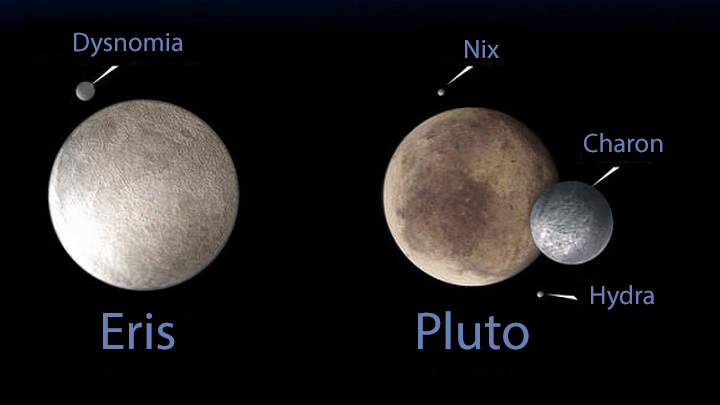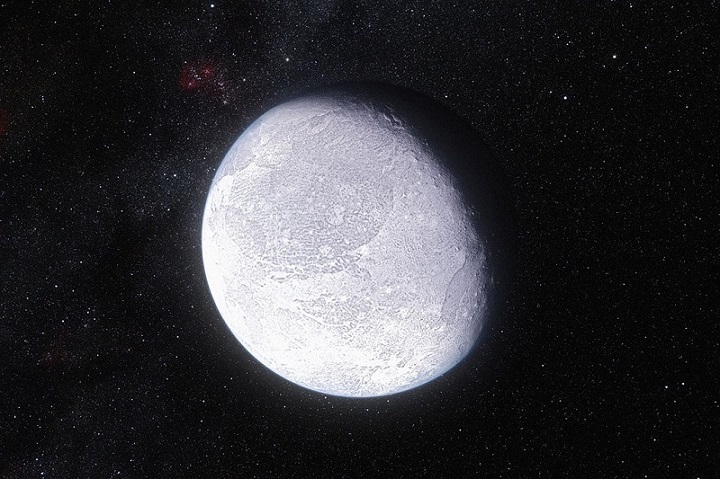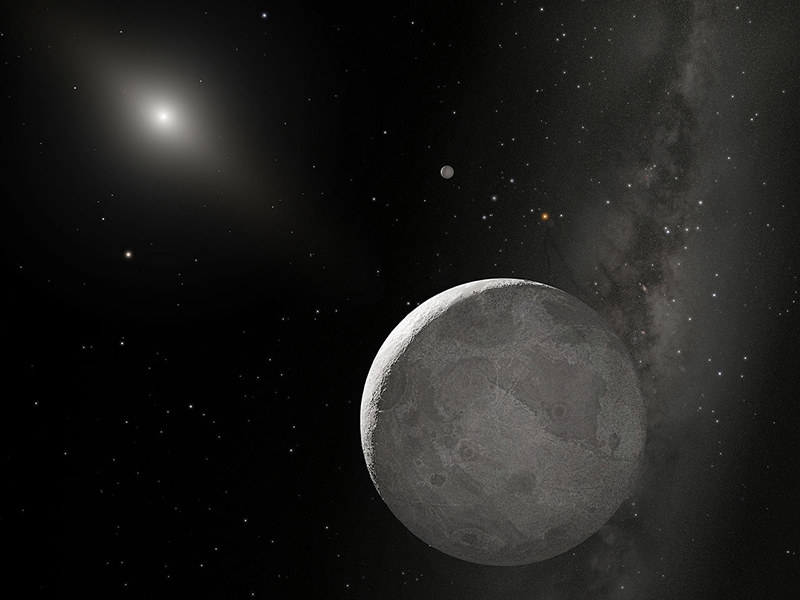The dwarf planet Eris has a very interesting history. When it was discovered, it was almost given the status of a planet! But the discovery of Eris became a catalyst for some changes in the scientific community, and it hastened the resolution of some old disputes.
Top facts about dwarf planet Eris
- Eris is the most distant from the Sun of all the dwarf planets. But far beyond its orbit, there are other plutoids that fit the title of a dwarf planet, and will probably get it soon.
- Eris had a chance to get the status of a tenth planet. But in 2006 Pluto was reclassified from normal planets to dwarf ones, and Eris lost this chance.
- Eris is slightly smaller than Pluto, it is lesser than ~30 miles (50 km) in diameter. However, it is the most massive one of all the dwarf planets.
- The diameter of Eris is 1445 miles (2326 km). This is 2.5 times the diameter of Ceres, the smallest and closest to the Sun dwarf planet located in the asteroid belt.
- It reflects almost all the light that falls on it – the albedo of Eris is incredibly high, 96%. To make it clearer, 100% is a perfect mirror, and 0% is an all-black body.

- It is still unknown whether there is a change of seasons on Eris since scientists have not yet established whether its axis is inclined in relation to the plane of rotation or not.
- A day on this dwarf planet lasts a bit longer than on Earth, about 25 hours and 54 minutes.
- It’s always very, very cold here. The average temperature on the surface is now -423 °F (-253 C°). As it gets closer to the Sun, it will warm slightly, but the temperature will still not rise above -382 °F (-230 C°).
- This dwarf planet has no atmosphere now, but in 250 years, when it gets closer to our star, the atmosphere will appear for a while. Some of the frozen substances on its surface will turn into a gaseous form because of warming, but when Eris moves away from the Sun, the atmosphere will freeze again and fall to the surface.
- Such a high albedo (reflectivity) of the surface of Eris is due to the fact that it is all covered with snow. However, this snow consists not of water, but of frozen methane.
- This dwarf planet was named after the eponymous goddess of strife from the ancient Greek Pantheon. And its moon is called Dysnomia – in the mythology of Ancient Greece, Dysnomia, the goddess of lawlessness, is the daughter of Eris.
- The asteroid belt contains the asteroid (718) Erida. A small confusion exists in Russian science because Russians use the same name for the asteroid and the dwarf planet – Erida.
- For the first time after opening, it was called 2003 UB, without having a proper name.
- Eris was going to be named Xena, after the main character of the series “Xena: Warrior Princess”, and her companion could have been named Gabriel, after the companion of Xena in this series. But at that time it still claimed to be a planet, and they are usually called the names of the old gods, so the idea was abandoned.
- A year there lasts 203.830 days, a bit more than 558 standard years.

- All planets (as well as Pluto and Ceres, discovered long ago) have their own symbols. Eris, however, doesn’t have it, as do other dwarf planets discovered in modern times.
- After its discovery, astronomers studied archival photographs and found Eris on many of them. It turns out that it could have been discovered in 1954 if we knew where to look.
- This dwarf planet in the outer Solar System is located 8.7 billion miles (14.3 billion km) from the Sun which is 96 times the distance between the Sun and Earth. Sunlight takes more than 13 hours to reach it. For comparison, the light goes to the Earth in only about 8 minutes.
- The spacecraft will take about 25 years to reach Eris. This is provided that the launch will be carried out in a suitable launch window so that the trajectory is close to the ideal one.
- Due to its high density (it is a third denser than Pluto), the gravity of Eris is not so weak, it is only 12 times weaker than Earth’s. For comparison, on the dwarf planet Ceres it’s 36 times weaker than on Earth.


